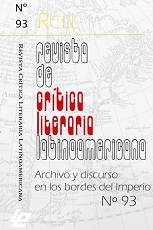Alterar los márgenes: anomalías en un mapa de Cuzco
Palavras-chave:
mapas, márgenes, indicialidad, poder colonialResumo
Ya Abraham Ortelius, el autor de la más importante cosmografía de su tiempo, hablaba de sí en tanto apasionado “lector” de mapas. De acuerdo con su propuesta, estos funcionarían no como documentos, sino como relatos con una capacidad de argumentación, de intriga, de transcurso discursivo y de conclusión climática. Sin embargo, la lectura de los mismos, al menos en su suerte colonial, está transitada de peligros, sobre todo si retratan regiones marginales, bordes y periferias respecto al centro de poder imperial. En alguna de tales ocasiones, sobre los laterales de la representación ocurren cambios, tropismos, alteraciones y mixturas que convierten al mapa en un hipertexto con un fuerte carga indicial, en un sentido menos semiótico que benjaminiano del término y capaz, por tanto, de ir más allá de su primera condición referencial e ilustrativa. Este artículo se plantea estudiar la configuración de la América virreinal y de sus márgenes como un espacio “anómalo” de representación, con la ayuda de un grabado de la ciudad del Cuzco que ofrece en sus muros extraños anacrónicas citas de una realidad periférica, heterogénea y en nada exacta.





